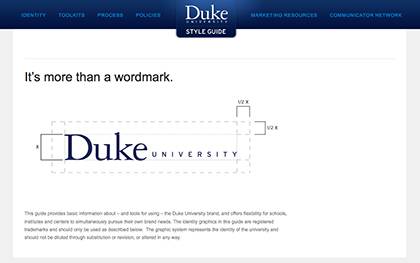Learn Duke’s ‘Style’ with Online Guide
Resource offers tools, tips and best practices for using Duke University brand

With hundreds of offices, departments and schools spread across Duke, there are lots of different ways faculty and staff represent their work and peers online, in print and across multimedia.
With help from Duke’s Office of Marketing and Strategic Communications, it’s easy to make the efforts of Duke community members more uniform when using Duke’s recently updated Style Guide. The guide is a free resource for all Duke community members to find more information about how to best showcase Duke’s identity when using logos, color palettes and other designs associated with the institution.
Read More“We’ve made the Style Guide for everyone - people who are brand new at Duke but also those who find themselves supporting a variety of materials or communications, from office assistants to managers,” said Denise Haviland, director of the Office of Marketing and Strategic Communications. “It’s important to use because it provides resources for projects and encourages brand consistency across Duke.”
Here are five ways you can use the style guide to better align projects with the university and to help make your work better.
1. Brand Identity
Duke employees know there’s a certain shade of blue for Duke’s official color, but did you know the official pantones for the university? For print materials, it’s PMS 287 or 288, and on the web, it’s Hex color 001A57.
Those shades and more are in the Style Guide, which also has word mark treatments, official school signatures and information on logos and fonts.
2. Tips, Tricks and Best Practices
The Style Guide contains a variety of toolkits that offer guidelines and tips for a variety of best practices in photography, social media and print and website media.
The Style Guide also offers a toolkit for creating videos, which features free tips, graphics and footage Duke employees can use.
“The graphics help create a consistent look and feel across university videos, and they save the video editor time,” said Carson Mataxis, senior visual media producer with the Office of News and Communications and University Development. “Managers that might book production companies can scan the best practices samples to determine what they are looking for and they can share these samples with the vendor to help set the bar for their video.”
3. Working with Outside Vendors
The Office of Marketing and Strategic Communications offers an outline of how to best seek partners for projects that might include video work, printing or other services. All work over $5,000 must be sent for bidding among vendors, which should include an internal Duke vendor. Projects below the $5,000 threshold don’t require bids but should still utilize recommended vendors.
4. Campus Guidelines and Policies
Whether you’re looking for information on copyright, filming guidelines or security requirements to protect data, the Style Guide has a list of ways to promote the ethical, legal and secure use of information at Duke.
5. Administrative Resources
In addition to highlighting the variety of internal resources like the Office of Trademark and Licensing that can help with projects and interoffice work, faculty and staff can also find a comprehensive list of Duke’s internal and external communication channels. The Style Guide can point employees to a multitude of ways to learn more about what Duke is doing and how Duke community members can promote their own news and announcements.